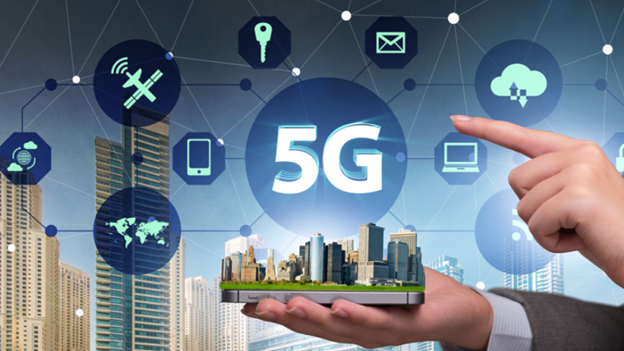As we traverse deeper into the 21st century, the evolution of mobile communication technology continues to shape and redefine the landscape of global connectivity. The latest leap in this progression is the deployment of 5G technology, a fifth-generation wireless network that promises to revolutionize how we interact with the digital world. With its unprecedented speed, low latency, and the potential to connect an immense number of devices simultaneously, 5G is poised to be a game-changer across various sectors.

Understanding 5G: A Brief Overview
5G, or fifth-generation wireless technology, represents the latest iteration of mobile networks, succeeding 4G LTE. While its predecessors primarily focused on enhancing mobile communication, 5G is designed to support a broader range of services, enabling everything from advanced mobile broadband to massive machine-type communications and ultra-reliable low-latency communications.
At its core, 5G operates on three spectrum bands: low-band, mid-band, and high-band (millimeter-wave). Each of these bands offers different advantages in terms of speed, coverage, and capacity. Low-band spectrum provides wide coverage and can penetrate buildings effectively, albeit with slower speeds. Mid-band spectrum offers a balance of coverage and speed, while high-band spectrum, though offering lightning-fast speeds, has a limited range and struggles with penetration through obstacles.
The Technological Pillars of 5G
Enhanced Mobile Broadband (eMBB)
Enhanced Mobile Broadband is one of the cornerstone features of 5G, promising to deliver significantly higher data rates than those offered by 4G LTE. With eMBB, users can expect download speeds of up to 10 Gbps, enabling seamless streaming of ultra-high-definition video content, rapid downloads, and the potential for entirely new forms of immersive media experiences, such as virtual and augmented reality.
Ultra-Reliable Low-Latency Communication (URLLC)
Latency, or the time it takes for data to travel from one point to another, is drastically reduced in 5G networks. URLLC in 5G can achieve latencies as low as 1 millisecond, which is crucial for applications requiring real-time responsiveness. This feature is particularly significant for autonomous vehicles, remote surgery, and industrial automation, where even the slightest delay can have serious consequences.
Massive Machine-Type Communication (mMTC)
The proliferation of the Internet of Things (IoT) has led to an explosion in the number of connected devices, ranging from smart home gadgets to industrial sensors. 5G’s mMTC capability allows for the simultaneous connection of billions of devices, facilitating seamless communication between machines with minimal human intervention. This will be a key enabler for smart cities, automated factories, and other IoT-driven environments.
The Impact of 5G on Industries
Healthcare
In healthcare, 5G has the potential to transform patient care through telemedicine, remote monitoring, and even robotic surgery. The low latency and high reliability of 5G networks enable real-time data transfer, making it possible for surgeons to perform operations remotely with precision. Moreover, continuous monitoring of patients through wearable devices can lead to earlier diagnosis and better management of chronic conditions.
Automotive
The automotive industry is set to undergo a significant transformation with the advent of 5G. Autonomous vehicles rely heavily on real-time data processing and communication, both of which are made possible by 5G’s low-latency networks. Additionally, 5G will enable vehicle-to-vehicle (V2V) and vehicle-to-infrastructure (V2I) communication, paving the way for safer, more efficient roads and the eventual realization of fully autonomous transportation.
Manufacturing and Industry 4.0
In manufacturing, 5G is a critical component of the Industry 4.0 revolution, which emphasizes the integration of digital technologies into production processes. With its ability to connect vast numbers of devices and provide reliable low-latency communication, 5G enables the development of smart factories, where machines, robots, and sensors can communicate and collaborate in real time. This leads to greater efficiency, reduced downtime, and more flexible production lines.
Challenges and Considerations
While the potential of 5G is vast, its deployment is not without challenges. One of the primary concerns is the significant investment required to build the necessary infrastructure. The deployment of 5G, especially the high-band millimeter-wave networks, necessitates the installation of a large number of small cells, as these high-frequency signals have a limited range and are easily obstructed.
Moreover, there are ongoing discussions about the potential health impacts of prolonged exposure to high-frequency electromagnetic fields used in 5G. Although the scientific community largely agrees that 5G is safe, these concerns have led to public hesitance in some areas.
The Future of 5G
As 5G technology continues to roll out globally, its impact will only grow more profound. Beyond the immediate benefits of faster speeds and lower latency, 5G will serve as the foundation for future technological advancements, including the widespread adoption of artificial intelligence, advanced robotics, and the next generation of immersive media.
In conclusion, 5G technology represents a monumental shift in the way we connect, communicate, and interact with the world around us. Its influence will be felt across industries, transforming everything from healthcare to manufacturing, and laying the groundwork for a more interconnected and intelligent future. As with any transformative technology, the full extent of its impact will unfold over time, but one thing is certain: 5G is set to redefine the boundaries of what is possible in the digital age.